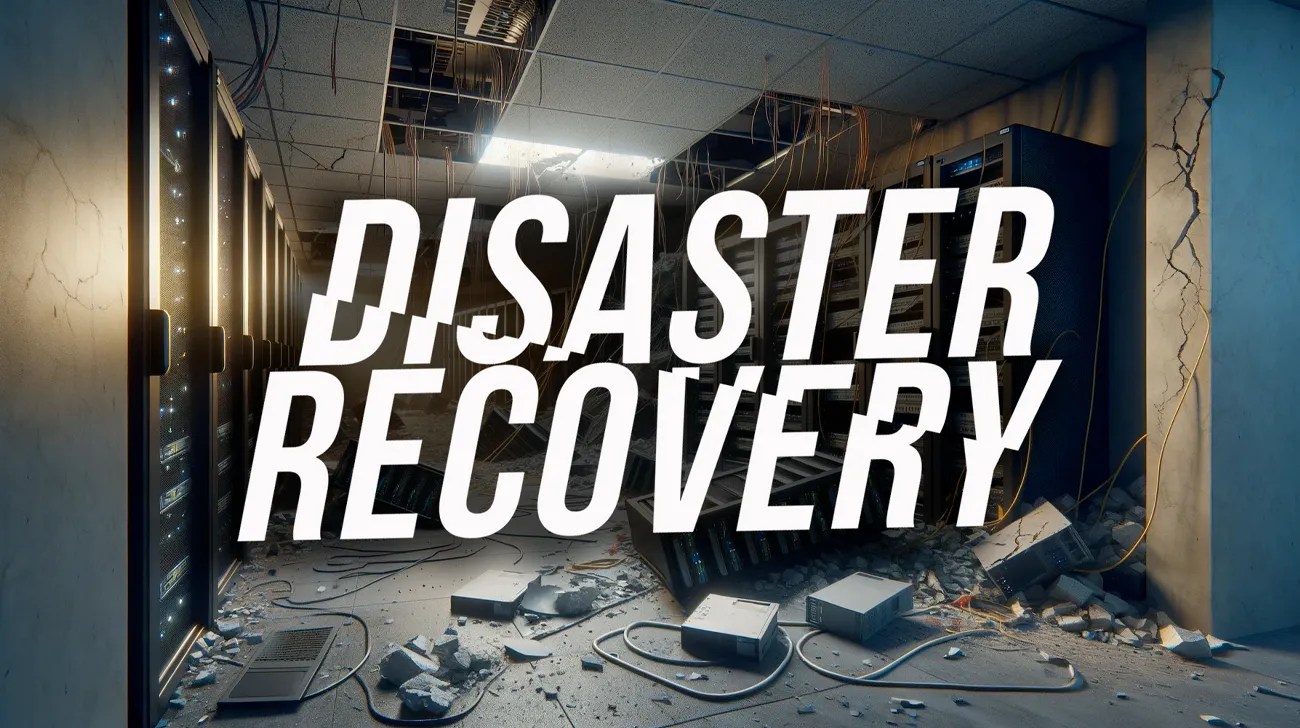What is Disaster Recovery? In the fast-paced world of IT, where data is the lifeblood of businesses, the term “disaster recovery” holds immense significance.
It refers to the strategic processes and procedures organizations implement to ensure their critical data. Also, IT systems can be recovered and restored swiftly in the event of a disaster or disruptive incident.
These disasters can range from natural calamities like hurricanes and earthquakes to cyberattacks, hardware failures, and human errors.
In this comprehensive guide, we will delve into the world of disaster recovery (DR), exploring its meaning and definition.
We will also have a look at the importance of disaster recovery planning, the significance of testing, the distinction between Recovery Point Objective (RPO) and Recovery Time Objective (RTO), and practical steps for implementing a robust disaster recovery plan.
Additionally, we will share a real-world example of disaster recovery during Hurricane Laura, highlighting the crucial role played by our innovative product.
Disaster Recovery Plan: Meaning & Definition
At its core, a Disaster Recovery Plan (DRP) is a documented set of procedures and protocols designed to minimize data loss as well as downtime and service disruption. It also guarantees business during and after a disaster or unexpected event.
A well-crafted DRP encompasses not only IT systems and data but also outlines the responsibilities of key personnel, communication strategies, and the allocation of resources to ensure a swift and effective recovery process.
The primary objective of a DRP is to enable an organization to continue its critical operations as seamlessly as possible in the face of adversity.
It aims to protect an organization’s reputation, customer trust, and financial stability by ensuring that critical data and services remain accessible, even in the worst-case scenario.
Therefore, the implementation of solutions like the PATCHBOX Cable Management System can be crucial for companies and data centers to get back online as quickly as possible.
Disaster Recovery Example PDF: PATCHBOX & Hurricane Laura
In August 2020, Hurricane Laura struck the U.S. Gulf Coast, leaving a trail of destruction in its wake. During this catastrophic event, PATCHBOX played a pivotal role in disaster recovery efforts.
One of its customers, TRG Datacenters, was tasked with migrating servers from the Lake Charles data center to the Houston data center. This ensured the continuity of operations for numerous small businesses.
Over the course of just 36 hours, TRG Datacenters, with the help of the innovative PATCHBOX, successfully got 27 small businesses back online, allowing thousands of employees to resume work.
The seamless execution of this disaster recovery plan was made possible by PATCHBOX, which eliminated the need for complex cabling planning, saving valuable time and effort.
This real-world example underscores the critical importance of disaster recovery planning and the impact it can have on businesses’ ability to recover swiftly from catastrophic events.
Read the full story in our Example PDF. Click here to to download it for free.
What is the Difference Between RPO and RTO? Meaning & Definition
Recovery Point Objective (RPO) and Recovery Time Objective (RTO) are two crucial metrics in disaster recovery planning.
Recovery Point Objective (RPO): RPO defines the maximum acceptable data loss that an organization can tolerate. It signifies the point in time to which data must be restored following a disaster.
For example, an organization with an RPO of one hour cannot afford to lose more than one hour’s worth of data. RPO is closely tied to data replication and backup strategies.
Recovery Time Objective (RTO): RTO represents the maximum allowable downtime for an organization’s critical systems and services.
It specifies how quickly IT systems should be recovered after a disaster. Achieving a low RTO requires efficient backup solutions, system redundancy, and rapid recovery processes.
Balancing RPO and RTO is a critical aspect of DR planning, as it determines the cost of the recovery solution and the level of protection it offers.
How do you calculate RTO and RPO?
Calculating RPO and RTO involves assessing your organization’s specific needs and considering the potential impact of data loss and downtime. The goal is to align these objectives with the available resources and technologies.
The formula for calculating RPO and RTO varies depending on your IT environment’s complexity and your systems’ criticality.
For RPO, you need to determine how often data is backed up and replicated, taking into account the data volume and bandwidth available.
RTO calculations require evaluating the time it takes to recover individual systems or services. To do so, consider factors like hardware redundancy and data recovery capabilities.
The most important Metrics
The following metrics and statistics play a pivotal role in assessing the effectiveness and readiness of an organization’s disaster recovery plan.
Among the myriad of metrics and stats available, several stand out as the most crucial for ensuring that a DR strategy can provide the necessary protection and resilience.
First and foremost, Recovery Time Objective (RTO) is a cornerstone metric. It defines the maximum acceptable downtime for critical systems and services during a disaster.
Downtimes are costly and can lead to long-lasting damage within a company. As this is a very important topic, we recommend our Whitepaper on the consequences of poor cable management. You can download it here for free.
Meeting RTO objectives is paramount, as it directly impacts an organization’s ability to maintain operations and minimize disruption.
Equally vital is the Recovery Point Objective (RPO), which dictates the allowable data loss in the event of a disaster.
RPO measures how frequently data is backed up and replicated, aligning it with business needs and ensuring that valuable information is not lost during recovery efforts.
Downtime metrics are also of utmost importance. These statistics track the duration and frequency of system unavailability. This offers a clear picture of the impact of disasters on productivity and revenue.
Understanding the financial implications of downtime can drive home the significance of a robust disaster recovery plan.
The success rate of recovery attempts is another key metric. It reveals the percentage of successful recoveries compared to total attempts. The success rate sheds light on the effectiveness of the plan’s execution.
Finally, the cost of downtime cannot be underestimated. This metric quantifies the financial consequences of disrupted operations, including lost revenue, customer dissatisfaction, and recovery expenses.
It provides a compelling argument for investing in comprehensive disaster recovery solutions.
Collectively, these metrics and stats empower organizations to evaluate their DR preparedness, identify weaknesses, and make informed decisions to enhance their resilience.
By monitoring and analyzing these critical indicators, businesses can prioritize disaster recovery efforts, minimize risks, and ensure that they are well-equipped to weather any storm or disruption.
How to implement a Disaster Recovery Plan
Implementing a robust disaster recovery plan requires a systematic approach. Here are the key steps to consider:
Assessment and Risk Analysis: Begin by identifying potential risks and assessing their impact on your organization. This includes evaluating the likelihood of various disaster scenarios and understanding their consequences.
Set Objectives and Priorities: Define clear RPO and RTO objectives based on your risk assessment. Determine which systems and data are mission-critical and prioritize their recovery.
Technology and Infrastructure: Invest in the necessary technology and infrastructure to support your disaster recovery plan. This may include data backup solutions, redundant hardware, offsite data centers and innovative IT products, like the PATCHBOX Cable Management.
Document the DRP: Create a comprehensive disaster recovery plan that outlines all procedures, responsibilities, and communication protocols. Ensure that all key personnel are trained and familiar with the plan.
Testing and Training: Regularly test your DRP through simulations and exercises. Use these tests to identify weaknesses and make necessary adjustments. Train employees on their roles during a disaster.
Regular Updates and Maintenance: Continuously update your disaster recovery plan to account for changes in technology, infrastructure, and business processes. Ensure that it remains relevant and effective.
Communication and Reporting: Establish clear communication channels for alerting employees, stakeholders, and customers during a disaster. Develop a reporting system to keep everyone informed about the recovery progress.
Monitoring and Compliance: Implement monitoring tools to track the health of your IT systems and data. Ensure that your disaster recovery plan complies with relevant regulations and industry standards.
Disaster Recovery Testing
Effective disaster recovery planning is incomplete without rigorous testing. Regular testing of the DRP is essential to identify potential weaknesses. It allows assessment of the feasibility of recovery objectives and train personnel involved in executing the plan.
Testing allows organizations to fine-tune their strategies, ensuring that in a real disaster, the plan will function as intended.
Common methods of disaster recovery testing include tabletop exercises, partial failovers, and full-scale simulations. Each approach serves a specific purpose, helping organizations evaluate their readiness and refine their procedures.
Conclusion
In today’s digital age, DR is not merely an option but a necessity for businesses of all sizes.
Understanding the meaning and importance of disaster recovery planning, testing, and implementation is crucial for safeguarding your organization’s data, reputation, and continuity in the face of unforeseen challenges.
By following best practices and staying vigilant, you can ensure that your disaster recovery plan is ready to face any adversity that comes your way.











